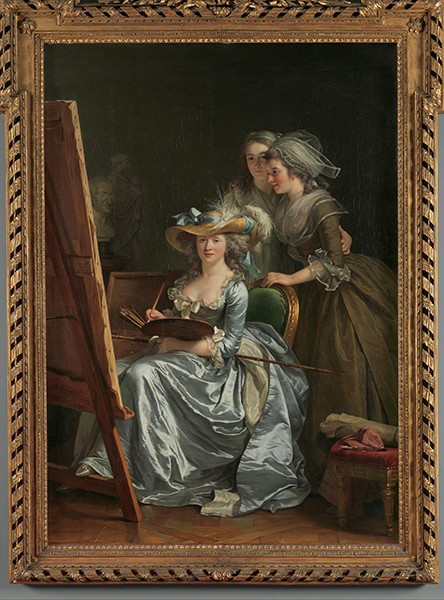Happy Birthday Adélaïde Labille-Guiard
April 11th is the birthday of one of the leading women artists of pre-Revolutionary France, Adélaïde Labille-Guiard. A fantastic portraitist, she’s right up with her contemporary Élisabeth Vigée Le Brun (1755–1842) in her contributions to French painting, although she was much more of an advocate for the education of women artists. This is not taught in Western art history texts!
 |
| Adélaïde Labille-Guiard (1749–1803, France), Self-Portrait with Two Pupils, Marie-Gabrielle Capet (1761–1818) and Marie Marguerite Carreaux de Rosemont (died 1788), 1785. Oil on canvas, 6'9" x 5' (210.8 x 151.1 cm). Metropolitan Museum of Art, New York. (8S-30335) |
Labille-Guiard mastered the technique of depicting sumptuous materials, although there is less allusion to a sumptuous life (outside of her dress), as this was painted on the eve of the French Revolution (1789–1794). There are tributes to the nascent Neoclassical movement—as if a nod to the coming storm—in the antique sculptures barely visible in the background, as well as the columnar leg of the small footstool on the right painted in the Neoclassical Louis XVI fashion.
During the 1700s, the academy system was introduced to regulate artistic production and patronage in many European countries. The academies established standards for educating and training artists, and hierarchies for subject matter and style. Few women were allowed into the academies, although some eventually gained access. The easiest way for a woman to be trained as an artist was still with a male relative or a fellow female artist. However, this period witnessed the beginning of the practice of commissioning women artists to teach classes of young women students at the academies, and it witnessed the ascension of a new class of professional women artists who dedicated their lives to their vocation.
Portraiture and still life—numbers three and four in the hierarchy of painting subject matter at the art academies—were what most women trained in. The highest categories, history and religious subjects, were considered "ill-suited" to women. The artist of this painting has turned the easel away from the viewer, as if to intimate that she is working on a large history subject, although it may actually be this self-portrait. Additionally, the subjects display the same idealized, mask-like features with doe-eyes and rosebud mouth as seen in the portraits of Labille-Guiard's rival, Vigée Le Brun.
The daughter of a fashionable hat maker in Paris, Labille-Guiard was probably taught reading and writing in a convent, as many middle-class women were. Her first instruction in art was with François Elie Vincent (1708–1790), a miniaturist whose shop was down the street from her father’s. Being taught by someone other than a family member signaled a major change in women’s training in art at the time.
Vincent trained Labille-Guiard in oils, while Maurice Quentin de la Tour (1704–1788) taught her pastels. Both artists were superb portraitists who worked in the academic realist style that was fashionable during the mid-1700s. Typical of the Rococo period, their portraits flattered the sitter with superficial elegance and emphasis on sumptuous materials. Labille-Guiard learned their incisive observation of detail but divested her portraits of most of the artificiality.
Labille-Guiard was a member of the Academy of Saint Luke, less prestigious than the Royal Academy, which held the yearly salons that were so important in helping aspiring artists obtain patrons. She exhibited for the first time at the Academy of Saint Luke in 1774. However, she wanted to be able to exhibit in the Royal Academy, which drew a much larger and more influential public. She succeeded in being admitted to the Academy in 1783, the same year as Vigée Le Brun.
Because most of Labille-Guiard’s sitters were wealthy women, she was known as a Peintre des Mesdames (Painter of Ladies). After being admitted to the Academy, her chief goal was to be given the title of history painter, but her training with portraitists never equipped her to produce the huge canvases required for history subjects. She vigorously supported her female students, always pushing for the Academy to admit more women as members.
Correlations to Davis programs: Explorations in Art 2E Grade 1: 2.1; Explorations in Art 2E Grade 2: 2.3; Explorations in Art 2E Grade 3: 1.1; Explorations in Art 2E Grade 6: 1.9; A Global Experience 2E: 2.3

Comments